Beelink GTR7 mini-PC Review: A Complete AMD Phoenix Package at 65W
by Ganesh T S on August 24, 2023 8:00 AM ESTSystem Performance: Application-Specific Workloads
Standardized benchmarks such as UL's PCMark 10 and BAPCo's SYSmark take a holistic view of the system and process a wide range of workloads to arrive at a single score. Some systems are required to excel at specific tasks - so it is often helpful to see how a computer performs in specific scenarios such as rendering, transcoding, JavaScript execution (web browsing), etc. This section presents focused benchmark numbers for specific application scenarios.
3D Rendering - CINEBENCH R23
We use CINEBENCH R23 for 3D rendering evaluation. R23 provides two benchmark modes - single threaded and multi-threaded. Evaluation of different PC configurations in both supported modes provided us the following results.
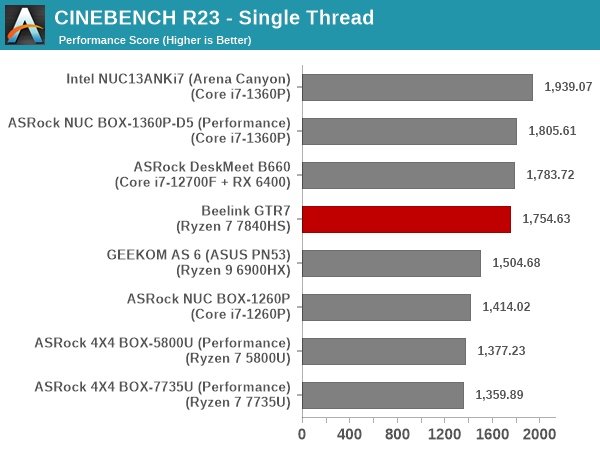
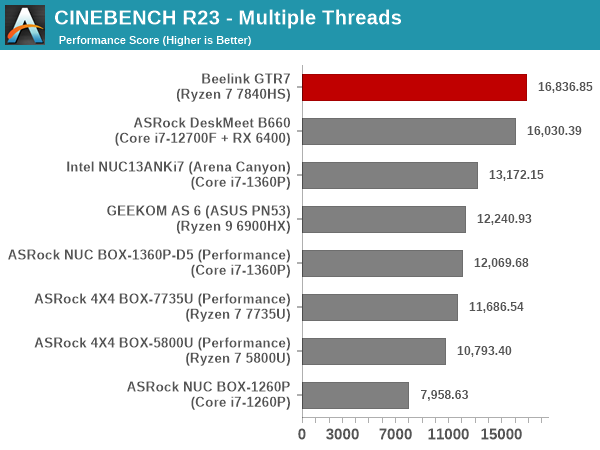
The performance in the multi-threaded case is a slam dunk for the GTR7. We see a significant improvement in the single thread scores over the Rembrandt-R systems, thanks to the higher power budget and newer microarchitecture (as well as faster RAM). However, the Raptor Lake-P NUCs seem to come away with the bragging rights for the single-threaded benchmark version.
Transcoding: Handbrake 1.5.1
Handbrake is one of the most user-friendly open source transcoding front-ends in the market. It allows users to opt for either software-based higher quality processing or hardware-based fast processing in their transcoding jobs. Our new test suite uses the 'Tears of Steel' 4K AVC video as input and transcodes it with a quality setting of 19 to create a 720p AVC stream and a 1080p HEVC stream.
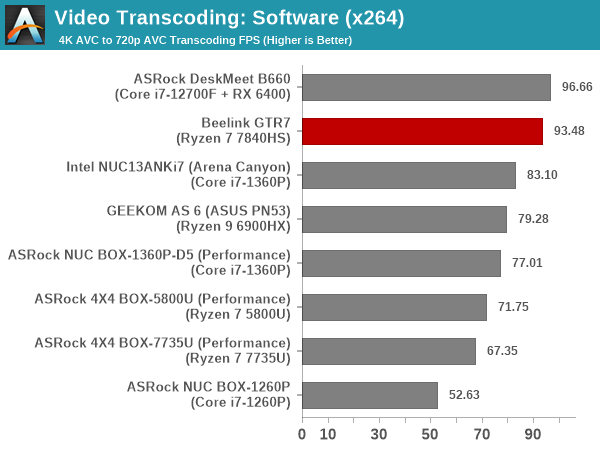
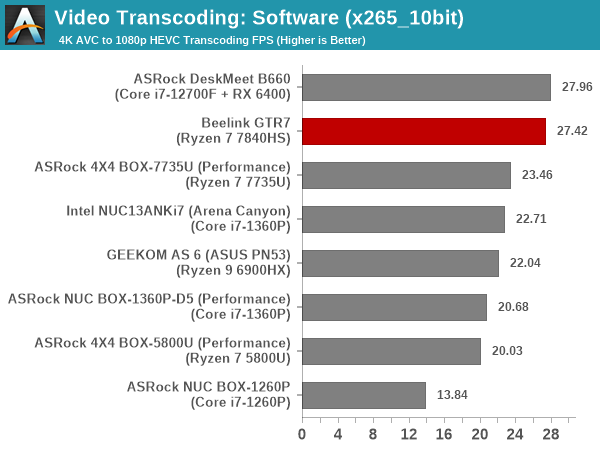
The presence of eight high-performance cores in the GTR7 gives it a very good advantage for this multi-threaded benchmark. Higher power budget translates to higher performance given that most of the systems have the same core counts. The GTR7 has a well-defined lead over other UCFF systems, and is neck-to-neck against the Alder Lake SFF PC with a dedicated 65W budget for the CPU alone.

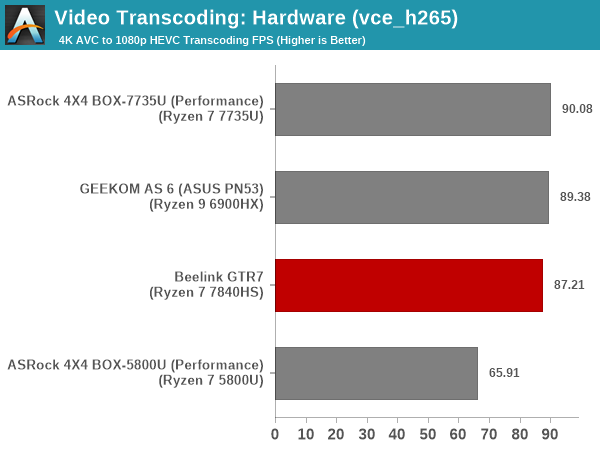
Hardware transcoding is available in the form of the VCE feature in the GPU. Intel systems have QuickSync, but a direct comparison is not advisable given that the encoding quality may differ. So, the comparison in the above graphs is restricted to AMD systems. The FPS is a function of the GPU clock rate and is directly tied to the available power budget. However, we do not find much difference in the transcoding rates between the Rembrandt-R and Phoenix systems.
Archiving: 7-Zip 21.7
The 7-Zip benchmark is carried over from our previous test suite with an update to the latest version of the open source compression / decompression software.
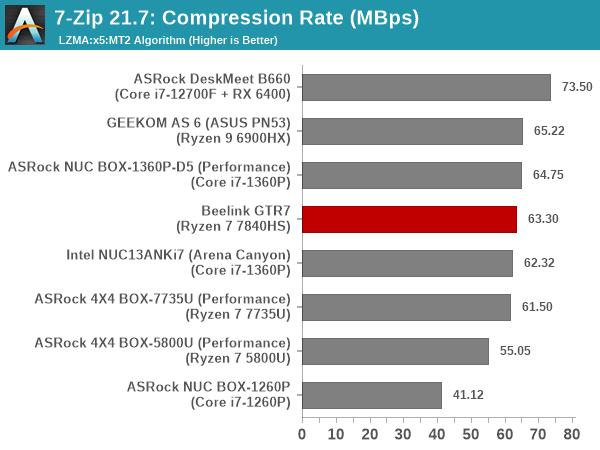
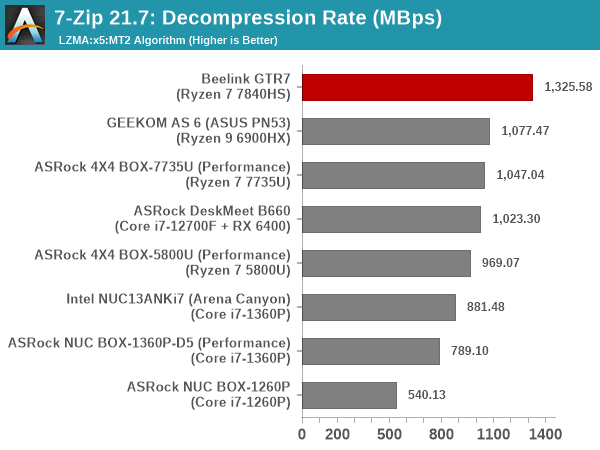
While there is not much separating the different UCFF systems in terms of compression rates, decompression is a completely different story with the 65W Phoenix system enjoying close to a 25% advantage over the 35W Rembrandt-R systems.
Web Browsing: JetStream, Speedometer, and Principled Technologies WebXPRT4
Web browser-based workloads have emerged as a major component of the typical home and business PC usage scenarios. For headless systems, many applications based on JavaScript are becoming relevant too. In order to evaluate systems for their JavaScript execution efficiency, we are carrying over the browser-focused benchmarks from the WebKit developers used in our notebook reviews. Hosted at BrowserBench, JetStream 2.0 benchmarks JavaScript and WebAssembly performance, while Speedometer measures web application responsiveness.

Raptor Lake-P seems to enjoy a slight advantage in single-threaded performance, and that gives the NUCs based on them an edge across all considered browsers in the JetStream 2.0 workload. The GTR7 slots in the upper half of the pack, with an improvement over the 35W Rembrandt-R systems. The same behavior is seen in the Speedometer 2.0 benchmark also.
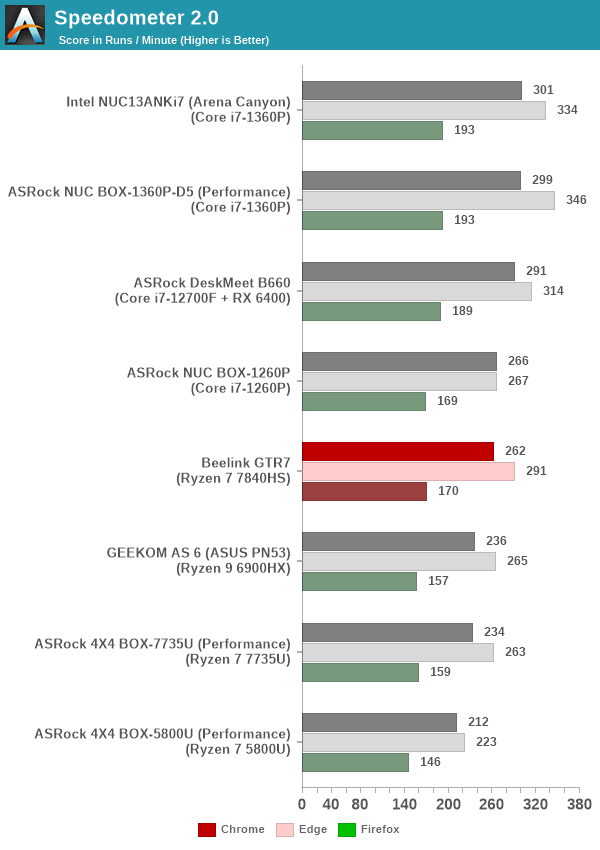
From a real-life workload perspective, we also process WebXPRT4 from Principled Technologies. WebXPRT4 benchmarks the performance of some popular JavaScript libraries that are widely used in websites.
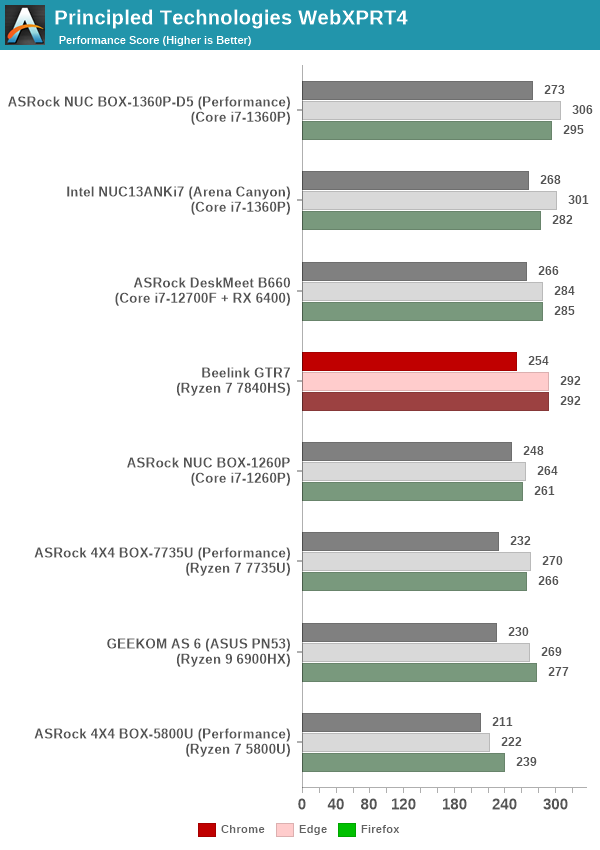
The GTR7 performs much better in this case, almost tying the ASRock Industrial NUC BOX-1360P/D5 in performance across multiple browsers. The higher power budget gives the GTR7 an edge over the considered Rembrandt-R systems. Overall, JavaScript performance seems to be primarily impacted by single-threaded performance.
Application Startup: GIMP 2.10.30
A new addition to our systems test suite is AppTimer - a benchmark that loads up a program and determines how long it takes for it to accept user inputs. We use GIMP 2.10.30 with a 50MB multi-layered xcf file as input. What we test here is the first run as well as the cached run - normally on the first time a user loads the GIMP package from a fresh install, the system has to configure a few dozen files that remain optimized on subsequent opening. For our test we delete those configured optimized files in order to force a ???fresh load??? every second time the software is run.
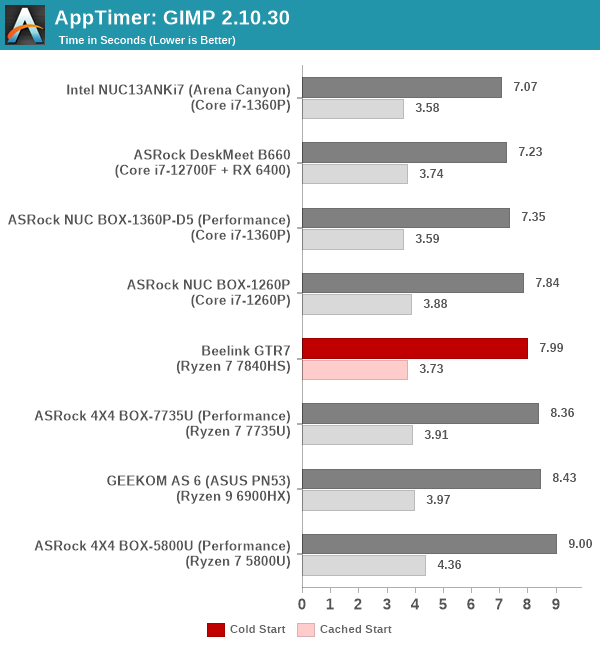
As it turns out, GIMP does optimizations for every CPU thread in the system, which requires that higher thread-count processors take a lot longer to run. So the test runs quick on systems with fewer threads, however fast cores are also needed. While the GTR7 is better than the Rembrandt-R systems on both counts, the Intel-based NUCs turn up with faster application launches under the considered conditions.
Cryptography Benchmarks
Cryptography has become an indispensable part of our interaction with computing systems. Almost all modern systems have some sort of hardware-acceleration for making cryptographic operations faster and more power efficient. In the case of IoT servers, many applications - including web server functionality and VPN - need cryptography acceleration.
BitLocker is a Windows features that encrypts entire disk volumes. While drives that offer encryption capabilities are dealt with using that feature, most legacy systems and external drives have to use the host system implementation. Windows has no direct benchmark for BitLocker. However, we cooked up a BitLocker operation sequence to determine the adeptness of the system at handling BitLocker operations. We start off with a 4.5GB RAM drive in which a 4GB VHD (virtual hard disk) is created. This VHD is then mounted, and BitLocker is enabled on the volume. Once the BitLocker encryption process gets done, BitLocker is disabled. This triggers a decryption process. The times taken to complete the encryption and decryption are recorded. This process is repeated 25 times, and the average of the last 20 iterations is graphed below.
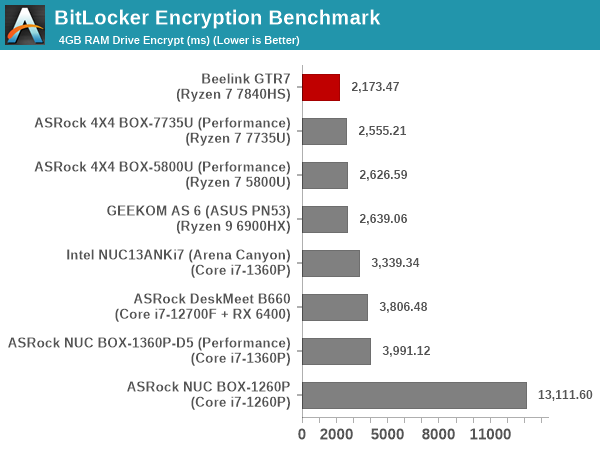
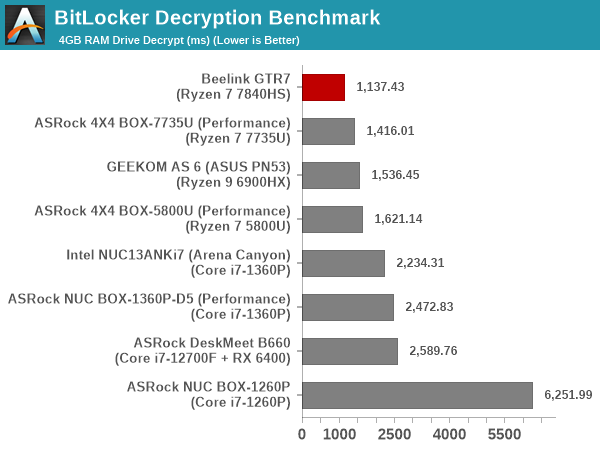
Hardware acceleration is available for the operations in all of the systems. The time taken for processing is directly dependent on the RAM speeds, available power budget, and core counts. As a result, it is no surprise that the GTR7 with DDR5-5600 RAM, 65W budget and eight high-performance cores manages to take the top spot by a comfortable margin.










56 Comments
View All Comments
holymaniac1 - Thursday, August 24, 2023 - link
What do you mean? "Windows is unable to present a 4K UI as a result, and the desktop resolution remains fixed at 1080p."Does that mean my PC monitor cannot be full 4K resolution? That's nuts!
ganeshts - Thursday, August 24, 2023 - link
Please re-read the context of that statement - it is when UMA Buffer Size is set to 'Auto'. By default, it is set to 4G by Beelink. In that setting, there is no trouble outputting 4K to the monitor.The statement was made as a feedback for Beelink to ensure that BIOS parameters are labeled in a logical and user-friendly manner.
Oxford Guy - Thursday, August 24, 2023 - link
I hope the Bee in the name isn't about the noise from the fan in this thing. I didn't see any mention of that but perhaps I missed it.mode_13h - Saturday, August 26, 2023 - link
Good question. STH reviewed the same unit and had fairly positive things to say about its noise profile and levels:https://www.servethehome.com/beelink-gtr7-changes-...
Sne4ky - Friday, August 25, 2023 - link
Does anyone have info if it’s support external gpu?And is this desktop or mobile cpu? So later on the cpu can be swapped for another?
meacupla - Friday, August 25, 2023 - link
It can do external GPU over USB4 or NVMe to occulink/PCIe adapterIt's a laptop CPU, and it's not user replaceable.
deil - Friday, August 25, 2023 - link
That puny fan looks like an AliExpress keychain replica of what you really wanted to order.....To be honest they should give you this if you pick 35W TDP and 65W should have raiser and good Noctua slim 120mm fan underneath.
I might seriously consider this, but that fan is seriously under powered for what they put in this box.
meacupla - Friday, August 25, 2023 - link
The fan might be underpowered, but the real issue is the SSD heatsink. It doesn't cover the entire length, and the pads don't make good contact with the controller.I don't think a 120mm would fit. 92mm slim maybe?
I think something like an Airjet cooler would do wonders in here. Particularly with the RAM.
ganeshts - Friday, August 25, 2023 - link
The lower SODIMM stick definitely needs airflow, as seen in the 10C temperature difference in our stress test.As for the SSD, I don't think it is much of a concern because the segment not covered by the heatsink is directly under the system fan - so it gets plenty of airflow.
Could the thermals be better? Absolutely. But, would I trade the fan for an extended SSD heatsink? Probably not, because that would mean sacrificing airflow for the RAM (there is not much place in the internal shroud to place the fan otherwise, without affecting airflow to either the RAM or the SSD).
meacupla - Friday, August 25, 2023 - link
Honestly, I think they should switch over to CAMM. Lower Z height, and don't have to worry about blocked airflow.